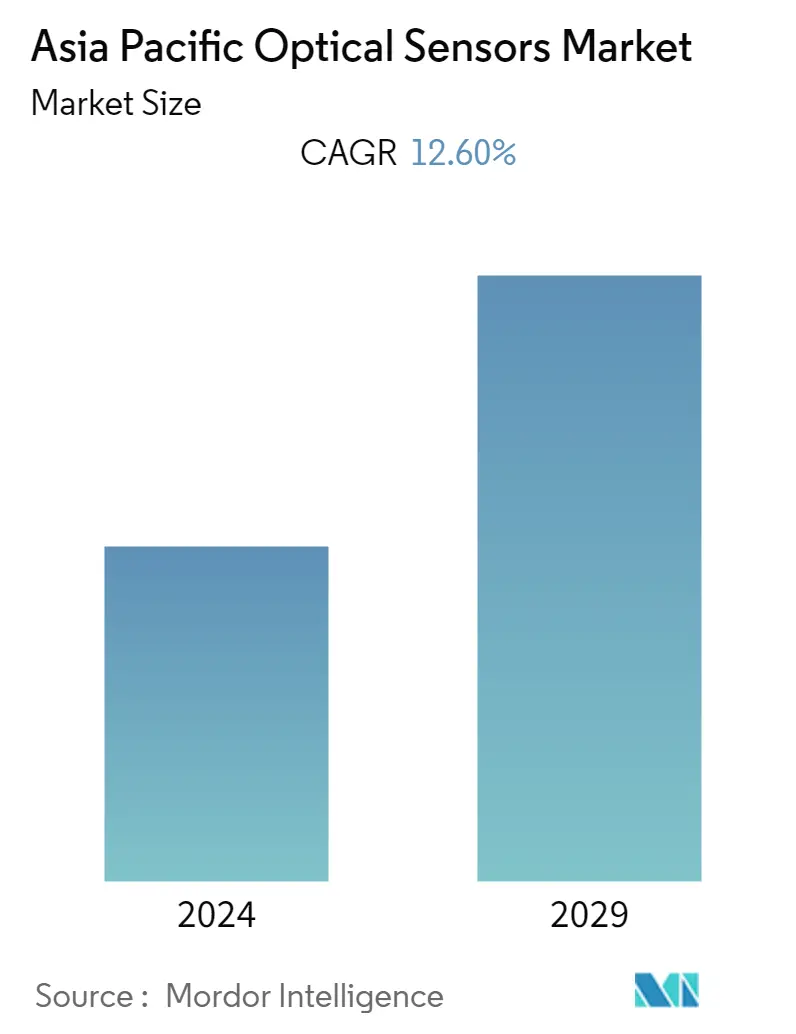Market Size of Asia Pacific Optical Sensors Industry

| Study Period | 2019 - 2029 |
| Base Year For Estimation | 2023 |
| Forecast Data Period | 2024 - 2029 |
| Historical Data Period | 2019 - 2022 |
| CAGR | 12.60 % |
| Market Concentration | Medium |
Major Players
*Disclaimer: Major Players sorted in no particular order |
APAC Optical Sensors Market Analysis
Asia Pacific Optical Sensors Market is expected to grow at a CAGR of 12.6% over the forecast period. The growing demand for advanced security features in smartphones has resulted in the growth of these sensors. One of these features includes on-screen fingerprint scanning, an optical sensor that detects and verifies fingerprints, propelling the optical sensor market.
- Optical sensors are important electronic components that convert optical signal signals (incident light) into electronic signals. Optical sensors have very few commercial applications as stand-alone components. However, when integrated as a system with several measuring devices and electrical components, optical sensors gain a high market value due to the wide range of applications that exist across numerous end-user industries.
- Advancements in self-driving cars and Advanced Driver Assistance Systems have increased demand for these sensors in recent years. Because optical sensing solutions are considered a superior technology for measuring distances, positions, and displacements, they are increasingly used in self-driving automotive applications. Continuous development of light sources for optical sensors is also expected to play a crucial role on the road to automated, self-driving vehicles.
- Optical sensors developed based on molecularly imprinted nanomaterials (MIP) at the nanoscale outperform their conventional-sized counterparts. They are distinguished by their faster response time and ease of integration with other functionalities. In addition, the use of fiber-optic current and voltage sensors in electricity transmission, which offers significant advantages over traditional current and voltage measurement technologies, is expected to drive the market under consideration.
- Japan and India are the other two countries with a large number of electronics and semiconductor manufacturers as well as end-users. These two countries also reported more COVID-19 infected cases and are still fighting the virus's spread. Though the countries have relaxed the lockdown rules and allowed manufacturing plants to operate, the decrease in demand and supply has significantly impacted the optical sensors market players in both countries.
- However, several kinds of research are being conducted to utilize optical sensors for detecting the COVID-19 virus. In line with this, in April 2022, a nanotechnology research group from the University of Georgia announced the development of nanotechnology-based optical sensors for rapid coronavirus detection. Such developments in optical sensors and their increasing applications in the medical industry are expected to bolster market growth.
APAC Optical Sensors Industry Segmentation
Optical sensors are used in a variety of commercial and research applications, including quality and process control, medical devices, metrology, imaging, and remote sensing. The expectation that optical sensors will have significant advantages over conventional sensor types in terms of properties drives R&D in the field. Asia Pacific Optical Sensors Market is segmented by Sensor Type (Fiber Optic Sensors, Image Sensors, Position Sensors, Ambient light and Proximity Sensors, Infrared Sensors) by Application (Industrial, Medical, Biometric, Automotive, Consumer Electronics, Other Applications) and by Region.
| By Sensor Type | |
| Fiber Optic Sensors | |
| Image Sensors | |
| Position Sensors | |
| Ambient light | |
| Proximity Sensors | |
| Infrared Sensors |
| By Application | |
| Industrial | |
| Medical | |
| Biometric | |
| Automotive | |
| Consumer Electronics | |
| Other Applications |
| By Country | |
| China | |
| India | |
| South Korea | |
| Japan | |
| Rest of Asia Pacific |
Asia Pacific Optical Sensors Market Size Summary
The Asia Pacific optical sensors market is poised for significant growth, driven by the increasing demand for advanced security features in consumer electronics, particularly smartphones. Optical sensors, which convert optical signals into electronic signals, are becoming integral components in devices such as smartphones, laptops, and tablets, where they are used for applications like gesture recognition and biometric security. The automotive industry also contributes to market expansion, with optical sensors being crucial in self-driving cars and Advanced Driver Assistance Systems due to their superior capabilities in measuring distances and positions. The development of nanotechnology-based optical sensors for rapid virus detection highlights the expanding applications of these sensors in the medical field, further bolstering market growth.
The market landscape is characterized by a fragmented structure with several key players, including Rockwell Automation Inc., Atmel Corporation, and STMicroelectronics NV, who are actively pursuing strategic collaborations and acquisitions to enhance their market presence and product offerings. Innovations such as meta-optics and advancements in pixel resolution and size are opening new avenues for optical sensors, particularly in micro-engineered and nano-engineered applications. The growing interest in health and fitness in the Asia Pacific region is driving the adoption of optical sensors in wearable devices for health monitoring. As the demand for optical sensors continues to rise across various sectors, including consumer electronics, automotive, and healthcare, the market is expected to experience robust growth in the coming years.
Asia Pacific Optical Sensors Market Size - Table of Contents
-
1. MARKET INSIGHTS
-
1.1 Market Overview
-
1.2 Industry Attractiveness - Porters Five Forces Analysis
-
1.2.1 Bargaining Power of Suppliers
-
1.2.2 Bargaining Power of Buyers
-
1.2.3 Threat of New Entrants
-
1.2.4 Threat of Substitutes
-
1.2.5 Intensity of Competitive Rivalry
-
-
1.3 Industry Value Chain Analysis
-
1.4 Assessment of Impact of COVID-19 on the Market
-
-
2. MARKET SEGMENTATION
-
2.1 By Sensor Type
-
2.1.1 Fiber Optic Sensors
-
2.1.2 Image Sensors
-
2.1.3 Position Sensors
-
2.1.4 Ambient light
-
2.1.5 Proximity Sensors
-
2.1.6 Infrared Sensors
-
-
2.2 By Application
-
2.2.1 Industrial
-
2.2.2 Medical
-
2.2.3 Biometric
-
2.2.4 Automotive
-
2.2.5 Consumer Electronics
-
2.2.6 Other Applications
-
-
2.3 By Country
-
2.3.1 China
-
2.3.2 India
-
2.3.3 South Korea
-
2.3.4 Japan
-
2.3.5 Rest of Asia Pacific
-
-
Asia Pacific Optical Sensors Market Size FAQs
What is the current Asia Pacific Optical Sensors Market size?
The Asia Pacific Optical Sensors Market is projected to register a CAGR of 12.60% during the forecast period (2024-2029)
Who are the key players in Asia Pacific Optical Sensors Market?
Honeywell International Inc., Rockwell Automation Inc., Atmel Corporation, Robert Bosch GmbH and STMicroelectronics NV are the major companies operating in the Asia Pacific Optical Sensors Market.

